Chinese Journal of Tissue Engineering Research ›› 2019, Vol. 23 ›› Issue (27): 4291-4299.doi: 10.3969/j.issn.2095-4344.1374
Previous Articles Next Articles
Visualization analysis of Citespace V on sports fatigue protocols from the perspective of sports biomechanics
Liu Yang1, 2, 3, Wang Dexin1, 3, Cheng Lifen2, Huang Zhongwei4, Chen Zhiyong1, 5, Li Lei2
- (1School of Physical Education and Sport Training, Shanghai University of Sport, Shanghai 200438, China; 2College of Physical Education, Nanchang Normal University, Nanchang 330032, Jiangxi Province, China; 3Shanghai Key Lab of Human Performance Development and Security, Shanghai 200438, China; 4School of Physical Education, Jiamusi University, Jiamusi 154007, Heilongjiang Province, China; 5Department of Physical Education, Tongji Zhejiang College, Jiaxing 314051, Zhejiang Province, China)
-
Received:2019-04-11Online:2019-09-28Published:2019-09-28 -
Contact:Wang Dexin, PhD, Professor, Doctoral supervisor, School of Physical Education and Sport Training, Shanghai University of Sport, Shanghai 200438, China; Shanghai Key Lab of Human Performance Development and Security, Shanghai 200438, China -
About author:Liu Yang, Doctoral candidate, Associate professor, School of Physical Education and Sport Training, Shanghai University of Sport, Shanghai 200438, China; College of Physical Education, Nanchang Normal University, Nanchang 330032, Jiangxi Province, China; Shanghai Key Lab of Human Performance Development and Security, Shanghai 200438, China -
Supported by:the Jiangxi Provincial Department of Education Science and Technology Project, No. Gjj18103 (to LY); the Project of Shanghai Key Lab of Human Performance Development and Security, No. 11DZ2261100 (to WDX)
CLC Number:
Cite this article
Liu Yang1, 2, 3, Wang Dexin1, 3, Cheng Lifen2, Huang Zhongwei4, Chen Zhiyong1, 5, Li Lei2. Visualization analysis of Citespace V on sports fatigue protocols from the perspective of sports biomechanics[J]. Chinese Journal of Tissue Engineering Research, 2019, 23(27): 4291-4299.
share this article
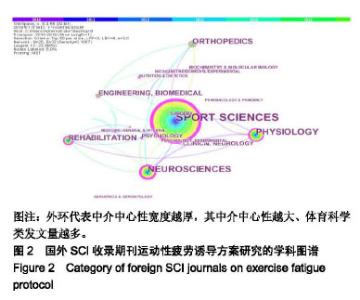
2.1 可视化图谱分析 2.1.1 疲劳诱导方案研究主要学科分布 在CitespaceⅤ界面上,时间分割(time slicing)为2010至2018,时间切片选择1,节点类型中选择category,修剪选择最小生成树计算法(minimum spaning tree)点击运行。在控制面板中,阈值(Threshold)设置4,字体大小(font size)设置为5节点(node size)设置15,调好颜色生成图2。学科主要涉及6类学科,依次顺序以及中介中心性是体育科学(0.73)、生理科学(0.28)、神经科学(0.50)、康复科学(0.31)、整形学科(0.13)、工程及生物力学(0.18)等,说明疲劳方案诱导相关设计主要依附在体育运动科学中经常使用。每一个节点代表一种学科,学者发文量越多,节点越大,节点之间的连线表明节点与节点之间的联系,线条曲线越粗表示关系越紧密;节点最外层的紫色外环表示文献的中介中心性,中介中心性是citspace知识图谱中起连接作用大小的度量。紫色外环宽度越厚,其中介中心性越大[11]。 "
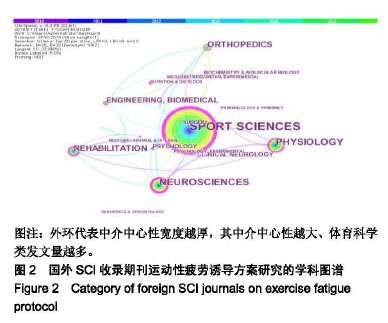
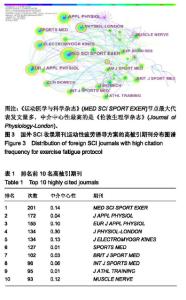
2.1.2 疲劳诱导方案研究主要高被引期刊 如图3所示,在CitespaceⅤ 功能参数区对参数进行设置,时间分割(time slicing)为2010至2018,1年1个时间切片,节点类型选择journal,修剪选择minimum spaning tree点击运行。图谱背景运行由黑色变成白色,在控制面板中把阈值设置90,字体设置6,节点大小设置为16,生成聚类图片。同时把排名前10的高被引期刊生成,分析其被引次数以及中介中心性大小。 表1显示《运动医学与科学杂志》(MED SCI SPORT EXER)排名第1,发文量最高;《应用生理学杂志》(J APPL PHYSIOL)排名第2;《欧洲应用生理学杂志》(EUR J APPL PHYSIOL)排名第3,《伦敦生理学杂志》(Journal of Physiology-London)排名第4;《肌电图与运动机能学杂志》(J ELECTROMYOGR KINES)排名第5,《运动医学》(SPORTS MED)排名第6,《英国运动医学杂志》(BRIT J SPORT MED)排名第7,《国际运动医学杂志》(INT J SPORTS MED)排名第8,《运动训练杂志》(J ATHL TRAINING)排名第9,《肌肉和神经杂志》(MUSCLE NERVE)排名第10。从中介中心性来看,《伦敦生理学杂志》(0.3)具有较高的中介中心性,《运动医学与科学杂志》(0.14)、《肌电图与运动机能学杂志》(0.13)说明这个3种期刊的发文质量文献影响力较大,对疲劳诱导方案的文献学者应该着重选择这3中期刊来源的文献。 "
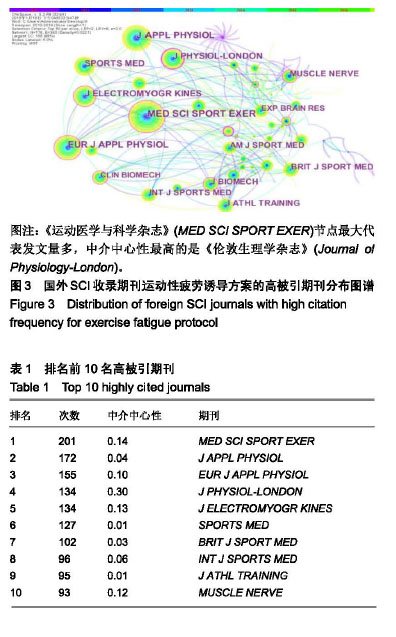
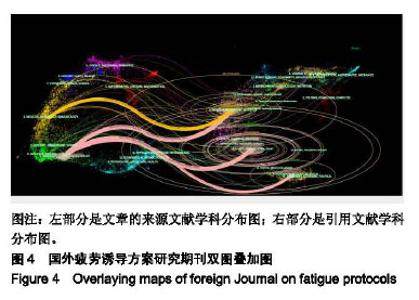
如图4所示,在CitespaceⅤ功能参数区对参数进行设置,Overlay Maps-JCR Journal maps,点击进入双图叠加界面,Overlay-add Overlay添加数据文献源,生成期刊双图叠加后,target circle设置150,采用Z scores调整聚类图形界面。利用期刊叠加图谱,每1个引用实例用1个圆弧表示,圆弧的发端引用基础论文中的来源期刊,末端被引基础图中目标期刊,来自相同集合的圆弧用相同颜色表示,以便来自不同集合的引用模式可以通过它们独特的颜色进行区分。图谱4分为2个部分:第1部分是文章的来源数据中的文献学科分布图;第2部分是文章数据中的引用文献学科分布图。这2部分以疲劳诱导方案为中介产生了学科耦合。第1部分文献来源中由3个圆弧形成的主要学科始端,研究内容中有运动性疲劳干预为主题的研究主要参考了神经学、体育科学、分子学、生物学及免疫学等学科;第2部分被引文献主要包括由4个圆弧汇聚成的3部分末端:主要涉及生物学、分子学、基因学、体育学、运动损伤康复学、心理学、教育学及社会科学等。 "
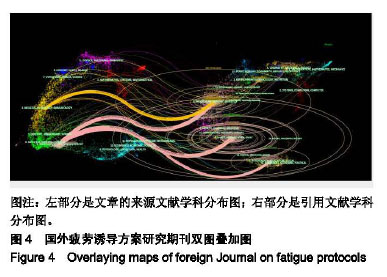
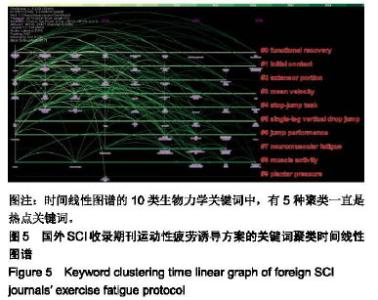
2.1.3 疲劳诱导方案研究关键词时间线性图谱分析 Node Types 选择节点keyword,时间节点2010至2018,时间切片选择1年。运行后,进行时间线视图谱聚类分析,调整图谱的颜色、线条、字体大小。Visualization-Grath View-Timeline view在生成时间线性图谱,将聚类编号作为Y轴,引文发表年份作为X轴,就可以布局得到共被引网络的时间线图谱,可以展现各个聚类(即子领域)发展演变的时间跨度和研究进程。如图5所示,2010至2018年的0#,1#,3#,5#,6#,8#所代表的聚类族具有很好的时间连续性。关键词聚类分析主要有功能性恢复(functional recovery)、直接接触(initial contact)、伸展部分(extensor portion)、平均速度(mean velocity)、急停起跳(stop-jump)、单腿垂直跳(single-leg vertical drop jump)、纵跳表现(jump performance)、神经肌肉疲劳(neuromusular fatigue)、肌肉活动(muscle activity)及足底压力(plantar pressure)。关键词时间聚类多数集中在运动生物力学研究范畴。功能性恢复、急停起跳、单腿垂直跳及纵跳表现等关键词的文献,研究目的主要涉及在疲劳后的落地-缓冲实验,分析膝关节的前交叉韧带损伤机制。从关键词共现可知,学科涉及生物力学相关前交叉韧带损伤及神经肌肉功能的研究为研究热点之一。 "
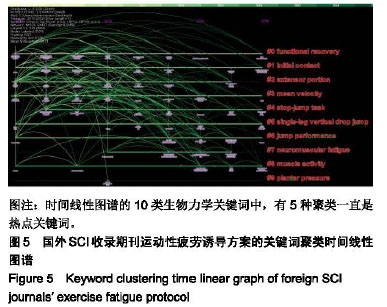
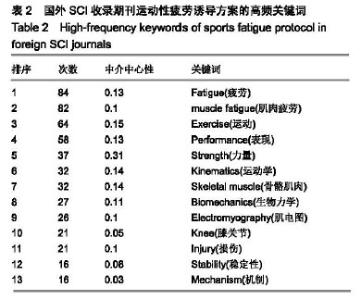
从表2可见,关键词突发频率以及中介中心性分析:疲劳(fatigue)、肌肉疲劳(muscle fatigue)、运动(exercise)为排名前3的高频关键词。力量(strength)中介中心性是0.31最高,运动学(kinematics)和骨骼肌肉(skeletal muscle)中介中心性为0.14。国外运动性疲劳诱导方案研究热点的关键词的主要在排序中:表现(performance)、力量(strength)、运动学(kinematics)、骨骼肌肉(skeletal muscle)、肌电图(electromyography)、稳定性(stability)、膝关节(knee)、损伤(injury)、生物力学(biomechanics)等关键词都包含运动生物力学研究的内容,因此,国外SCI收录期刊中关于运动性疲劳诱导研究方案主要击中的运动生物力学研究范畴。 "
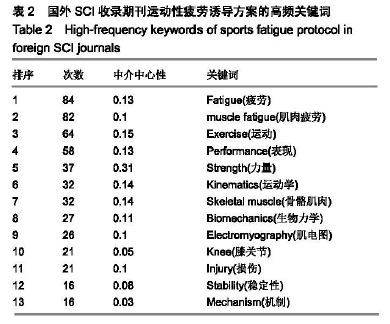
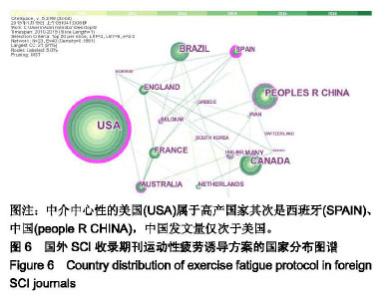
2.1.4 疲劳诱导方案研究主要国家分布 Node Types选择节点Country,阈值项选择“Top N per slice”,节点阈值设定为每个切片中频次最高的50。如图6所示,文章利用检索出来的354篇文献分布23个国家(地区),不同国家发文量及影响力不同。排名第1是美国,被引数量为97次;第2是加拿大,被引频次41次;第3为中国,共被引41次。第4是巴西,被引文献32次;第5是法国被引用次数为23次;第6是澳大利亚被引用次数为21次;第7是英国,被引频次19次;第8个是西班牙,被引频次为14次;第9是德国被引频次为13次;第10是荷兰共被引11次。从中介中心性来看(紫色外圈),美国0.78、西班牙为0.44,中国0.18发文影响力排名前3,这些国家对于疲劳干预性研究成果的影响力较大。"
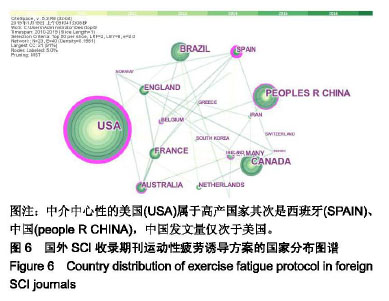
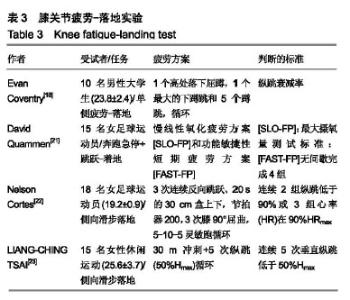
2.1.5 小结 从CitespaceⅤ知识图谱的主要学科、高被引期刊、关键词及国家分布综合分析后,获悉有关于运动性疲劳诱导方案干预主要涉及运动生物力学指标研究。因此,进一步深入探析高被引文献的疲劳模型设计、复制及评定是当前研究热点之一。 2.2 疲劳分类以及疲劳模型 根据疲劳出现部位的不同,疲劳模型可以划分为局部和全身性疲劳2种:局部疲劳模型主要分为,上肢疲劳模型、腰部以及躯干疲劳诱导模型以及下肢疲劳模型。目前运动与疲劳之间的关系已经形成了共识:运动一旦开始,人体生理疲劳就已经潜在的发生,只是这一现象难以被稳定的检测到[12]。 全身性疲劳方案主要包括“跑至疲劳”和“比赛疲劳”干预方案[13-14]。从知识图谱的高频关键词聚类获悉直接接触、平均速度、急停起跳、单腿垂直跳及纵跳表现等下肢落地表现是当今运动性疲劳干预方案研究的主要热点之一。关于下肢疲劳状态下的“疲劳-落地”或者高处落下的缓冲实验研究较多[15-18],模型主要针对如篮球、网球、排球、足球及体操等项目“疲劳-落地”的下肢关节着地后的策略改变,模型普适用于下肢肌群参与的运动项目。 由表3可见,当前关于“疲劳-着地”疲劳模型主要集中在“跑至疲劳”和“跑+纵跳”的疲劳方案。短时疲劳方案主要在纵跳、折返跑、短冲刺[16-29]、单腿蹲跳相有机结合。长时间全身性疲劳诱导方案主要集中在跑及跑步机上进行长时间跑[14,30-31],以VO2max不同百分比强度训练负荷至疲劳。这种疲劳方案目的主要进行全身性疲劳诱导,应用于人体由于机能疲劳后落地产生损伤的机制研究,实用性较强、疲劳方案简单、容易复制,多文献重复模仿疲劳方案设计。 "
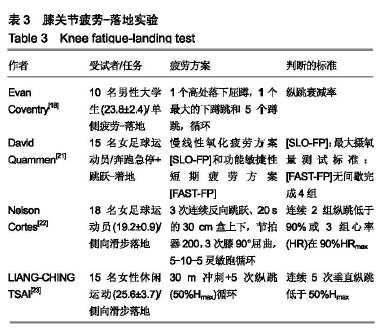
| [1]Ameli S, Naghdy F, Stirling D, et al. Quantitative and non-invasive measurement of exercise-induced fatigue. Proc Inst Mech Eng P J Sport Eng Technol. 2019;233(1):34-45.[2]Da Silva W, Machado AS, Souza MA. Can exercise-induced muscle damage be related to changes in skin temperature? Physiol Meas. 2018;39(10):22-30.[3]Twomey R, Wrightson J, Fletcher H. Exercise-induced fatigue in severe hypoxia after an intermittent hypoxic protocol. Med Sci Sports Exerc. 2017;49(12):2422-2432.[4]江婉婷,王兴,江志鹏.国外肌肉衰减综合征的运动疗法研究热点与内容分析-基于科学知识图谱的可视化研究[J].体育科学, 2017,37(6):75-83.[5]李金金.基于知识图谱的我国篮球运动研究态势可视化分析[J].福建体育科技,2018,37(5):31-33.[6]骆意.体操运动研究热点及演化分析-基于科学知识图谱的可视化分析[J].军事体育学报,2018,37(124): 99-106.[7]高瞻乐,王纯.基于知识图谱分析跑步过程中的生物力学的变化与特征[J].中国组织工程研究,2018,22(36):145-154.[8]夏培玲,王璟.基于知识图谱的国外高原训练研究前沿与热点分析[J].体育科学,2011,31(4):75-80.[9]基于知识图谱的国际有氧运动科学研究动态与演化分析[J].北京体育大学学报,2017,40(4):56-63.[10]近十五年我国德育研究热点及前沿趋势探微-基于文献计量学和科学知识图谱的可视化分析[J].山东师范大学学报(人文社会科学版),2018,63(5):70-82.[11]李小芬,许佳慧.国内外体育舞蹈研究进展分析-基于科学知识图谱的可视化研究[J].北京体育大学学报,2018,41(4):89-97.[12]Paris HL, Fulton TJ, Chapman RF. Effect of carbohydrate ingestion on central fatigue during prolonged running exercise in moderate hypoxia. J Appl Physiol (1985). 2019;126(1):141-151.[13]刘宇,张希妮,傅维杰,等.不同疲劳诱导方案对落地时下肢关节力学、刚度和能量吸收的影响[J].体育科学, 2017,37(11): 48-55.[14]Zhang XN, Fu WJ, Xia R, et al. Effects of exercise-induced fatigue on joint mechanics, stiffness, and energy absorption in lower extremity during landings. China Sport Sci. 2017; 37(11):48-55.[15]Adrian C, Duane K, Harter R, et al. Activity-specific effects of fatigue protocols may influence landing kinematics: a pilot study. Int J Exerc Sci. 2013;6(3):242.[16]Coventry E, O'connor KM, Hart BA, et al. The effect of lower extremity fatigue on shock attenuation during single-leg landing. Clin Biomechan. 2006;21(10):1090-1097.[17]Dufek JS, Bates BT. The evaluation and prediction of impact forces during landings. Med Sci Sports Exerc. 1990;22(3): 370-377.[18]Dufek JS, Bates BT, Davis HP, et al. Dynamic performance assessment of selected sport shoes on impact forces. Med Sci Sports Exerc. 1991;23(9):1062-1067.[19]Quammen D, Cortes N, Van Lunen BL, et al. Two different fatigue protocols and lower extremity motion patterns during a stop-jump task. J Athl Train. 2011;47(1):32-41.[20]Cortes N, Greska E, Kollock R, et al. Changes in lower extremity biomechanics due to a short-term fatigue protocol. J Athl Train. 2013;48(3):306-313.[21]Tsai LC, Sigward Susan M, Pollard Christine D, et al. Effects of fatigue and recovery on knee mechanics during side-step cutting. Med Sci Sports Exerc. 2009;41(10):1952.[22]Borotikar Bhushan S, Rhonda N, Ryan K, et al. Combined effects of fatigue and decision making on female lower limb landing postures: central and peripheral contributions to ACL injury risk. Clin Biomechan. 2008;23(1):81-92.[23]Chappell Jonathan D, Herman Daniel C, Knight Bradford S, et al. Effect of fatigue on knee kinetics and kinematics in stop-jump tasks. Am J Sports Med. 2005;33(7):1022.[24]Giorgio S, O’connor Kristian M. Fatigue-related changes in stance leg mechanics during sidestep cutting maneuvers. Clin Biomechan. 2008;23(7):946-954.[25]Mclean SG, Samorezov JE. Fatigue-induced ACL injury risk stems from a degradation in central control. Med Sci Sports Exerc. 2009;41(8):1661.[26]McLean SG, Huang X, van den Bogert AJ. Investigating isolated neuromuscular control contributions to non-contact anterior cruciate ligament injury risk via computer simulation methods. Clin Biomechan. 2008;23(7):926-936.[27]Mark M, Albert G. Submaximal fatigue of the hamstrings impairs specific reflex components and knee stability. Knee Surg Sports Traumatol Arthrosc. 2007;15(5):525-532.[28]Dominic G, Mark M, Albert G. Gender and fatigue have influence on knee joint control strategies during landing. Clin Biomechan. 2009;24(1):82-87.[29]Mclean Scott G, Bhushan B, Lucey Sarah M. Lower limb muscle pre-motor time measures during a choice reaction task associate with knee abduction loads during dynamic single leg landings. Clin Biomech (Bristol, Avon). 2010;25(6): 563-569.[30]罗小兵,马建.肌电图在运动性肌肉疲劳研究中的应用现状[J].成都体育学院学报,1999,25(4):66-70.[31]王芳.跑至疲劳过程中人体动作结构特征的变化规律[D].苏州:苏州大学,2009.[32]Lindström B, Karlsson S, Gerdle B. Knee extensor performance of dominant and non-dominant limb throughout repeated isokinetic contractions, with special reference to peak torque and mean frequency of the EMG. Clin Physiol. 2010;15(3):275-286.[33]Corin G., Strutton PH, Mcgregor AH. Establishment of a protocol to test fatigue of the trunk muscles. Br J Sports Med. 2005;39(10):731.[34]Vernillo G, Temesi J, Martin M, et al. Do aerobic characteristics explain isometric exercise-induced neuromuscular fatigue and recovery in upper and lower limbs? J Sports Sci. 2019;37(4):387-395.[35]McPhee M, Graven-Nielsen T. Alterations in temporal summation of pain and conditioned pain modulation across an episode of experimental exercise-induced low back pain. J Pain. 2018;20(3):264-276.[36]Hansen Jørgen W. Postoperative management in lumbar disc protrusions: i indications, method and results, II follow-up on a trained and an untrained group of patients. Acta Orthop Scand Suppl. 1964;71(Supp 71):1-47.[37]Murdock GH, Hubley-Kozey CL. Effect of a high intensity quadriceps fatigue protocol on knee joint mechanics and muscle activation during gait in young adults. Eur J Appl Physiol. 2012;112(2):439-449.[38]孙晓乐,夏锐,张希妮,等.疲劳干预对拉长-缩短周期动作中下肢生物力学的影响[J].中国运动医学杂志,2018,37(1):19-27.[39]Flouris AD, Koutedakis Y, Nevill A, et al. Enhancing specificity in proxy-design for the assessment of bioenergetics. J Sci Med Sport. 2004;7(2):197-204.[40]Metsios GS, Flouris AD, Koutedakis Y, et al. The effect of performance feedback on cardiorespiratory fitness field tests. J Sci Med Sport. 2006;9(3):263-266.[41]Hassanlouei H, Arendt-Nielsen L, Kersting UG, et al. Effect of exercise-induced fatigue on postural control of the knee. J Electromyogr Kinesiol. 2012;22(3):342-347.[42]Friesenbichler B, Stirling LM, Federolf P, et al. Tissue vibration in prolonged running. J Biomech. 2011;44(1):116-120.[43]Tripp Brady L, Yochem Eric M, Uhl Timothy L. Recovery of upper extremity sensorimotor system acuity in baseball athletes after a throwing-fatigue protocol. J Athl Train. 2007; 42(4):452.[44]Asmussen E. Muscle fatigue. Med Sci Sports. 1979;11(4): 313.[45]Pilegaard H, Domino K, Noland T, et al. Effect of high-intensity exercise training on lactate/H+ transport capacity in human skeletal muscle. Am J Physiol. 1999;276(2 Pt 1):E255.[46]Roush JR, DoVico K, Fairchild S. The effect of quality of movement on the single hop test in soccer players aged 15-16 years. Int J Allied Health Sci Prac. 2010;8(2):1-8.[47]Nakhostin Ansari N, Naghdi S, Karimi H, et al. A randomized controlled pilot study to investigate the effect of whole body vibration on lower extremity fatigue. J Sport Rehabil. 2016; 26(5):1.[48]Stulen FB, Deluca CJ. Frequency parameters of the myoelectric signal as a measure of muscle conduction velocity. IEEE Trans Biomed Eng. 1981;28(7):515-523.[49]Schweitzer TW, Fitzgerald JW, Bowden JA, et al. Spectral analysis of human inspiratory diaphragmatic electromyograms. J Appl Physiol Respir Environ Exerc Physiol. 1979;46(1):152.[50]Gross D, Grassino A, Ross WR, et al. Electromyogram pattern of diaphragmatic fatigue. J Appl Physiol. 1979;46(1):1.[51]Luca CJ. Myoelectrical manifestations of localized muscular fatigue in humans. Crit Rev Biomed Eng. 1984;11(4):251-279.[52]张强,胡婧,伍勰.不同分级神经肌肉疲劳对冲击性落地动作下肢生物力学的非线性影响[J].中国运动医学杂志, 2014,33(12): 1153-1160. |
| [1] | Pu Rui, Chen Ziyang, Yuan Lingyan. Characteristics and effects of exosomes from different cell sources in cardioprotection [J]. Chinese Journal of Tissue Engineering Research, 2021, 25(在线): 1-. |
| [2] | Xu Feng, Kang Hui, Wei Tanjun, Xi Jintao. Biomechanical analysis of different fixation methods of pedicle screws for thoracolumbar fracture [J]. Chinese Journal of Tissue Engineering Research, 2021, 25(9): 1313-1317. |
| [3] | Huang Zexiao, Yang Mei, Lin Shiwei, He Heyu. Correlation between the level of serum n-3 polyunsaturated fatty acids and quadriceps weakness in the early stage after total knee arthroplasty [J]. Chinese Journal of Tissue Engineering Research, 2021, 25(9): 1375-1380. |
| [4] | Chen Xinmin, Li Wenbiao, Xiong Kaikai, Xiong Xiaoyan, Zheng Liqin, Li Musheng, Zheng Yongze, Lin Ziling. Type A3.3 femoral intertrochanteric fracture with augmented proximal femoral nail anti-rotation in the elderly: finite element analysis of the optimal amount of bone cement [J]. Chinese Journal of Tissue Engineering Research, 2021, 25(9): 1404-1409. |
| [5] | Zhang Chao, Lü Xin. Heterotopic ossification after acetabular fracture fixation: risk factors, prevention and treatment progress [J]. Chinese Journal of Tissue Engineering Research, 2021, 25(9): 1434-1439. |
| [6] | Zhou Jihui, Li Xinzhi, Zhou You, Huang Wei, Chen Wenyao. Multiple problems in the selection of implants for patellar fracture [J]. Chinese Journal of Tissue Engineering Research, 2021, 25(9): 1440-1445. |
| [7] | Wang Debin, Bi Zhenggang. Related problems in anatomy mechanics, injury characteristics, fixed repair and three-dimensional technology application for olecranon fracture-dislocations [J]. Chinese Journal of Tissue Engineering Research, 2021, 25(9): 1446-1451. |
| [8] | Chen Junming, Yue Chen, He Peilin, Zhang Juntao, Sun Moyuan, Liu Youwen. Hip arthroplasty versus proximal femoral nail antirotation for intertrochanteric fractures in older adults: a meta-analysis [J]. Chinese Journal of Tissue Engineering Research, 2021, 25(9): 1452-1457. |
| [9] | Chen Jinping, Li Kui, Chen Qian, Guo Haoran, Zhang Yingbo, Wei Peng. Meta-analysis of the efficacy and safety of tranexamic acid in open spinal surgery [J]. Chinese Journal of Tissue Engineering Research, 2021, 25(9): 1458-1464. |
| [10] | Hu Kai, Qiao Xiaohong, Zhang Yonghong, Wang Dong, Qin Sihe. Treatment of displaced intra-articular calcaneal fractures with cannulated screws and plates: a meta-analysis of 15 randomized controlled trials [J]. Chinese Journal of Tissue Engineering Research, 2021, 25(9): 1465-1470. |
| [11] | Huang Dengcheng, Wang Zhike, Cao Xuewei. Comparison of the short-term efficacy of extracorporeal shock wave therapy for middle-aged and elderly knee osteoarthritis: a meta-analysis [J]. Chinese Journal of Tissue Engineering Research, 2021, 25(9): 1471-1476. |
| [12] | Luo Lin, Song Naiqing, Huang Jin, Zou Xiaodong. Review and prospect of international research on preschool children’s movement development assessment: a CiteSpace-based visual analysis [J]. Chinese Journal of Tissue Engineering Research, 2021, 25(8): 1270-1276. |
| [13] | Ji Zhixiang, Lan Changgong. Polymorphism of urate transporter in gout and its correlation with gout treatment [J]. Chinese Journal of Tissue Engineering Research, 2021, 25(8): 1290-1298. |
| [14] | Yuan Mei, Zhang Xinxin, Guo Yisha, Bi Xia. Diagnostic potential of circulating microRNA in vascular cognitive impairment [J]. Chinese Journal of Tissue Engineering Research, 2021, 25(8): 1299-1304. |
| [15] | Wang Yongsheng, Wu Yang, Li Yanchun. Effect of acute high-intensity exercise on appetite hormones in adults: a meta-analysis [J]. Chinese Journal of Tissue Engineering Research, 2021, 25(8): 1305-1312. |
| Viewed | ||||||
|
Full text |
|
|||||
|
Abstract |
|
|||||